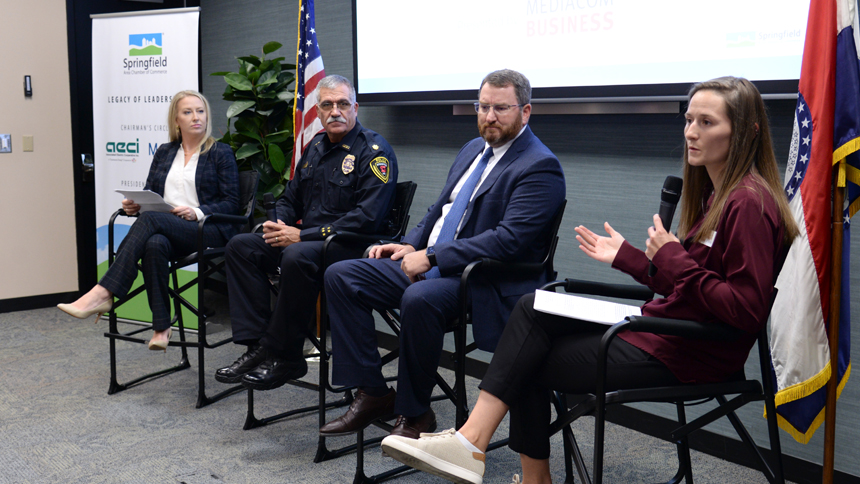Helping businesses connect with available tools and resources to prevent crime

Many of the tools referenced in this article can be found online in the Chamber’s Let’s Keep Springfield Safe Business Toolkit.
Take advantage of the crime prevention tools available to your business because focusing on prevention pays off. That was the main takeaway from the Chamber’s recent 60 Minutes to Success session focused on keeping our businesses and community safe.
Central Bank Vice President/Relationship Manager Stephanie Murphy moderated the program panel. Murphy also serves on the Chamber's Small Business Council. Attendees heard from Major Stacey Parton, Uniform Operations Bureau Commander of the Springfield Police Department (SPD), Greene County Prosecuting Attorney Dan Patterson, and Kirsten Whitehead, Project Manager with Paragon Architecture. The panelists shared actionable insights about crime prevention, prosecution, and innovative approaches to public safety.
Major Parton emphasized participating in SPD’s camera location registration program. “It’s a simple process to register,” Parton said. “Registering does not allow officers to monitor your camera footage. It only allows the department to know there are cameras in an area where a crime has occurred and that footage may be available.” Parton went on to point out that video footage is one of the best methods for identifying and apprehending criminals and convicting those who are caught in the act of committing a crime.
Parton also encouraged attendees to take advantage of their Police Area Representative, or PAR officer. The purpose of a Police Area Representative (PAR) officer is to have a direct contact for citizens when dealing with neighborhood concerns and complaints – that includes working with your business as part of the area in which you are located. PAR officers are assigned to a specific geographic area of the city and they work varying schedules, which allows them to focus the necessary attention to area concerns and complaints.
If your business is experiencing an ongoing problem in your neighborhood area and would like to discuss it with your PAR officer, first determine what police response area (or zone) you live in by checking the zone map (or call 864-1810 if you need further assistance). To find your neighborhood’s PAR officer visit the City’s website for a current list of PAR officers which includes their contact information.
“There’s a lot of ‘click bait’ out there about Springfield’s crime rate,” said Parton. “Data has often been used in a way that goes against FBI recommendations.” His advice for getting the most accurate data about what is happening here, and how our own numbers are trending over time, was to visit www.springfieldmo.gov/crime and click on “Annual Crime Reports”. There are annual reports, bi-annual crime reports, quarterly public safety reports and more.
Parton also suggested using the LexisNexis Community Crime map to monitor crime in real time in the area of your business location(s). With the tool, you can view and filter crime data in an interactive map and analytics dashboard to become better informed about crime activity in your area. You can also sign up for crime alerts to be sent to you.
“It’s important to report crime when it happens,” said Parton. “We want an accurate picture of what’s happening so we know where to focus. We are here for you and want to hear from you about what you need.”
Architect Kirsten Whitehead offered the unique perspective of a professional trained in Crime Prevention Through Environmental Design (CPTED). She highlighted the four CPTED design principles: natural surveillance, natural access control, territorial reinforcement, and maintenance and management. Together, these four principles serve as the foundation of this approach to designing the physical environment in a way that is mindful to preventing crime.
These principles can be applied when designing new construction as well as incorporated into renovation plans. They can also be represented by steps as simple as upgrading the brightness of exterior lighting and providing visible, informational signage. Whitehead emphasized the importance of sustaining the maintenance and management principle. Simply put, if a building and its surrounding area appear to be well-maintained and cared for, the location is less likely to become a target of crime.
Whitehead was asked if emergent technology can play a role in creating safer business and work environments. “Employing the design principles of CPTED is still the key,” she said. “When the environment is designed with crime prevention in mind, technology can more effectively support it.”
Greene County Prosecuting Attorney Dan Patterson coined his own acronym to help businesses prevent crime – CPTOD or crime prevention through operational design. Strong operational design, with checks and balances around financial transactions and other internal processes of the business, can help prevent or quickly spot theft, for example. “Listen to your lawyer. Listen to your accountant,” said Patterson. “Really review your audit and implement any recommended practices or operational changes that create more transparent processes. Most crimes are crimes are crimes of opportunity. If they don’t see an easy target, the criminal moves on.”
In terms of ensuring crimes are effectively prosecuted in our community, Patterson encouraged employers to accommodate employees called for jury duty or to testify as a witness. He also emphasized the importance of upgrading and maintaining camera surveillance systems. Make sure employees are properly trained to operate and utilize the system as appropriate. For example, if an employee puts surveillance footage on a flash drive for law enforcement, they should put their initials on it. They may need to testify later to identify the flash drive, to confirm that the system was working properly, and that the time code is accurate. That can be very important to successfully submitting camera footage to be used in a trial.
Patterson also touched on innovative partnerships and collaboration to strengthen the county’s entire criminal justice system. He shared more about the Greene County Family Justice Center as well as a Criminal Justice Roundtable which brings together the executive branch and the judicial branch to implement best practices.
“We have to find ways to move cases sooner so that our community has trust in the criminal justice system,” Patterson said. “We’re not a small community in terms of our judicial system anymore, so we have to be looking at ways to optimize limited resources to protect our community.”

